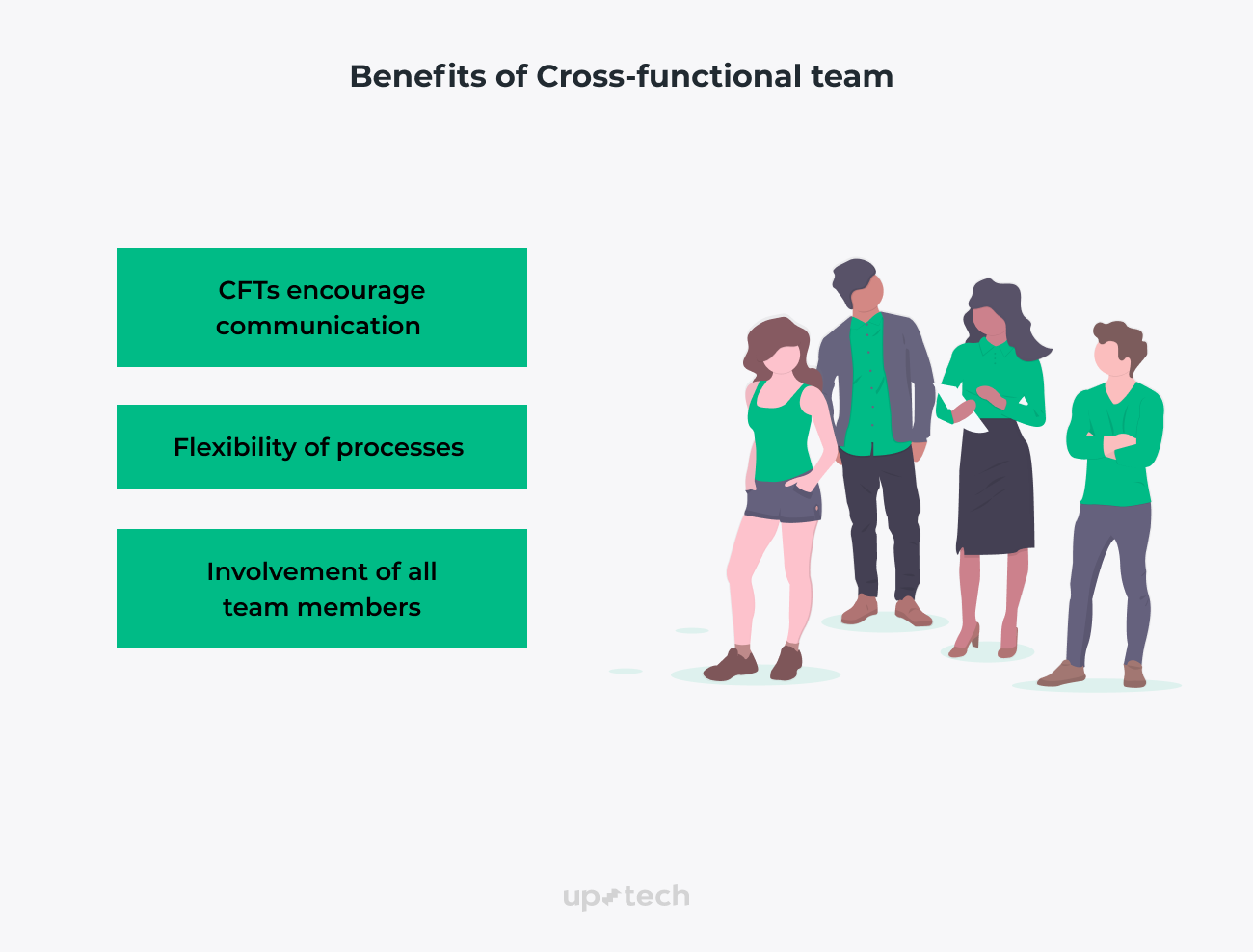Product development is a complicated process that unites the efforts of several teams: Devs, UX/UI Designers, QA, etc. Typically, each team emphasizes its own priorities, which often brings the product cycle into standstill. To avoid this, we turned to a cross-functional team approach and broke the deadlock.
In this article, we want to share some insights on how we organized a cross-functional team at Uptech, how it helped us to fill in the gaps in product development, and deliver a better product.
What is a cross-functional team?
A cross-functional team (CFT) includes specialists of different functional expertise who work together to achieve a common goal. Unlike functional teams, their cross-functional counterparts consist of specialists from different areas and levels in the company. Instead of carrying out tasks independently, the team members communicate and share ideas to develop a better solution.
The term “cross-functional team” comes from the Scrum product management framework, which defines the Scrum team as “self-organizing and cross-functional.” In practice, such groups are more open to flexibility, creativity, and productivity than functional teams.

Why we turned to cross-functional teams?
We used to build our process in functional teams, where designers, engineers, and QA specialists worked separately. This model fit the bill for some short-term projects. But when it came to such a complex project as Yaza with multiple Usability Tests and User interviews, the classic approach proved vain. And here is why:
Classic approach is more about execution than ideation
Though teams toil at the same project, professionals in such groups barely communicate (or even know each other's names). So it all comes down to simple task execution, leaving no room for discussion and creativity.
The initial stage of the Yaza project is considerably simple. Still, it demands room for creativity as we still had to define the products' value, target audience, and a list of specific features

Lack of shared understanding
To have synergistic teamwork, each member needs to have a shared vision of the final result. However, a proper discussion is out of the question for functional teams, as specialists often operate in a silo'
The final vision of Yaza evolved drastically throughout the timeline. We needed a framework where we could sync our activities to make sure we are on the same page.
Constant handoff of requirements
In functional teams, specialists work separately, and one may only receive the project requirement after another member completes his/her task.
When we started developing Yaza – a mobile live-streaming platform, it became clear that this handoff will hinder the product development cycle. So we decided to go for a cross-functional approach, which perfectly smoothed all the deficiencies of the classic approach.

How a cross-functional team approach helped us to build a better product?
When we're building Yaza, we realized that it is impossible to reach our goals with the traditional approach. The development of Yaza involved a continuous Discovery stage. We wanted to conduct interviews and user tests, gather feedback, and verify our hypotheses to explore the target audience's real needs. The functional approach would restrict us in this endeavor. So we turned towards a cross-functional team and the results are immediate.
Here are the benefits, that we found out:
CFTs encourage communication
CFT brings skilled professionals from different departments together to share knowledge and ideas. It blurs the organizational boundaries and allows for a collaborative environment.
Flexibility of processes
Working in groups helps team members bring effective solutions faster and be more flexible at changing them anytime. Instead of waiting until one department completes the task, team members can discuss and validate ideas right off the bat. This paves the way for quick hypotheses’ validation and productive discovery stage.
Involvement of all team members
CFT opens the way to creativity, as each specialist can share his/her opinion on the subject and receive instant feedback from others.

How we organize work in a cross-functional team?
It is worth mentioning that CFTs are only useful when appropriately organized. Hence, I will unveil how to manage a cross-functional team to good effects.
Basically, we hold regular Agile sprint meetings. However, there are four types of meeting that we prioritize:
- Product discovery meetings. At this stage, we visualize the product we are going to develop. We do this by answering the question, “why are we building the product?”, defining the business model, and building the project roadmap.
- Daily check-ins. Here we look back at what’s been done and figure out what to do next. Check-in helps us to track each other’s performance and help each other overcome blockers.
- Grooming meetings. This is where we assess the remaining scope of work and make plans for the next sprint.
- Planning meetings to make sure the team is prepared to get the right things done for every sprint.
.png)
4 tips you need to know to build a cross-functional team that works
Here are some tips on building a cross-functional team successfully based on our experience at Uptech.
Streamline communication in CFT
Smooth communication is the backbone of the CFT approach. But it is important that team meetings are not chaotic and time-consuming. Set up schedules, prepare agenda and plan your meetings, so that your team is always in the know of what is to be discussed.
Use CFTs for long-term projects
Meetings take a large amount of time in CFTs, which might not fit short-term technical projects with a predefined scope of work.
Inversely, long-term projects which involve several stages of development (from a prototype to MVP), including hypothesis validation and usability testing will benefit from the cross-functional approach.
Involve all team members from the start
It would be best if you involved all team members at any stage of product development. For example, this is a common misstep when engineers are not involved in the Software Product Discovery. We recommend inviting all team members, including developers, to user interviews, testing and ideation, allowing everyone to input in the project.
Cultivate the spirit of collaboration
CFT is about creativity and brainstorming. And these two are inconceivable without a team of motivated individuals who bring things forward. So take your time to get out the project’s message to your team and inspire them to move forward.
Summary
Building a cross-functional team is a demanding process. It takes quite a while for professionals with different backgrounds to be on the same page and head towards a common goal.
However, the efforts you invested to create such a team pay off with flexibility, creativity, and better user feedback.
Uptech team is always ready to adapt to your needs and find a development approach that suits your idea. Contact our product managers to figure out the framework that works best for you.










































































.avif)

























